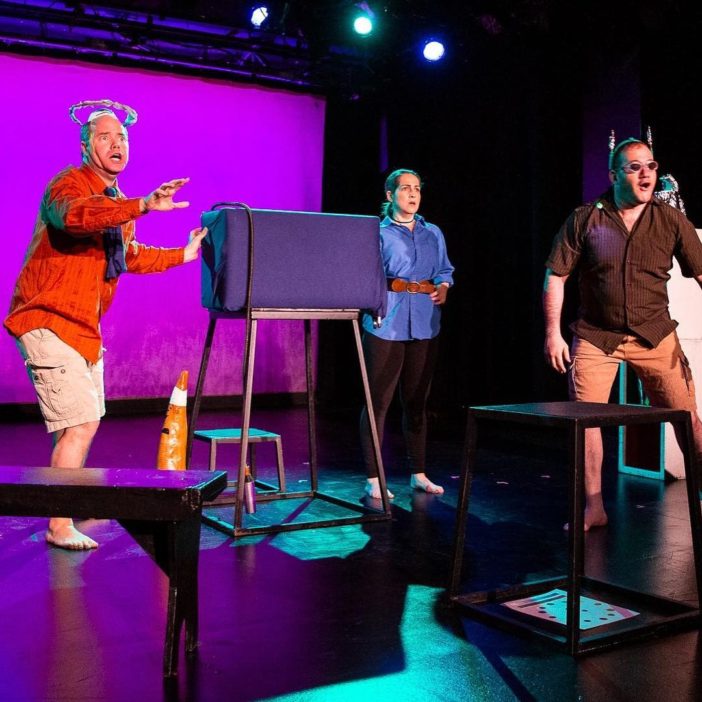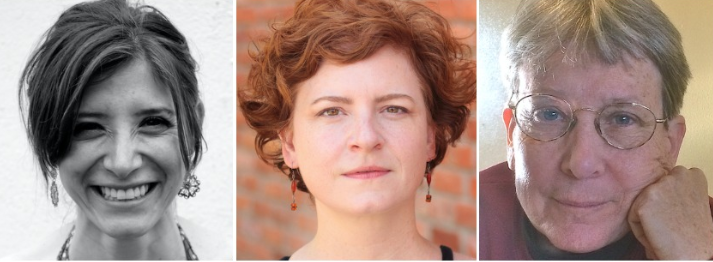With two productions running in the same small city, Eugene, OR, I thought it would be fun to feature the three directors, all women, and a bit about their creative process. Not only do these shows have women directors, but they both have women stage managers, lighting designers, costumer designers and box office managers. Pretty cool. Let’s meet the teams, starting with Elizabeth Helman!
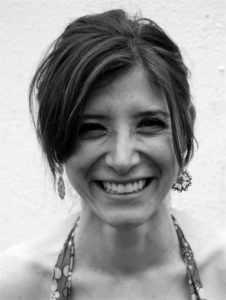
Hi, Liz Helman! What inspires your creativity?
Liz: In short, inspiration is everywhere.
The longer answer about inspiration and creativity is that these are, in many ways, two separate issues. For me, part of working in the arts means I need to live my life in such a way that I am constantly receptive to the world around me and that I have a responsibility to learn whatever I can wherever I can. Inspiration in and of itself, can come from anywhere at any time if I am open to follow it. Making theatre is a combination of telling stories and teaching empathy, so learning different perspectives and how to communicate is invaluable when it comes to reaching an audience. I consume all types of media and the study of history, art, philosophy, politics, religion, literature as a means of increasing my ability to tell different stories through theatre. Creativity itself is an ongoing process that requires dedication and the ability to solve problems. It’s work. It takes focus, time, energy, and a willingness to work through challenges with a playful sense of curiosity. Form forces creativity so it’s actually a lot easier to work on a commissioned project where the parameters are already set (ie. “you will direct this play in this space at this time and you have five dollars to do it” or “you will write a script with four characters about such-and-such historical figure and it opens in two weeks”) – while every project has its challenges, usually when I’m hired to direct a play a lot of the unknowns are already taken care of and I can focus on filling in the rest of the blanks to tell the story. In the cases where a project is more open-ended, I need to be disciplined enough to build the sandbox myself for everyone else to play in.
Tell me about your directorial process tackling the short plays in Bunfight.
My process for Bunfight wasn’t that much different than I usually work except that the plays were shorter and new. There was no production history or preconceived ideas about what any of these plays were supposed to be. Because these are all new works, I felt it was my job to try and get into the playwright’s head and communicate their vision of reality in an honest way rather than hyper-conceptualize them as I might do with a Shakespeare play. I start with any play by just reading through the script a few times to discover the story. What is this play really about? And I mean in the simplest of terms. Love. Friendship. Loneliness. Fear. Whatever. And then I build out from there to the more specifics of time, place, sociopolitical realities, gender relationships, etc. For example, at its center, I think that Contrapposto is a play about control.
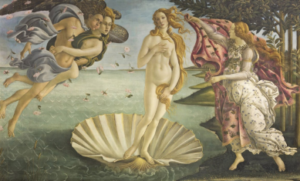
Both Sandy and Venus want to control the narrative, but in the world of Renaissance Italy, only one of them can. While Sandy is enough of a humanist to appreciate Venus for her role in inspiring artists, he is still very much a part of a world where the idea that men and women could be equal or that women are full-formed and rational human beings is inconceivable. He sees this painting as an honor, but unfortunately by placing her on a pedestal, he dehumanizes her and denies her own agency. While she can be defiant, he still “wins” in the end. At some point in every process, I remind the cast, when it gets down to it for all the rehearsal and bits and business and work, just “tell the fucking story.” That’s how I start every play, asking myself “what’s the fucking story here?” And then working with the cast and designers to just tell the fucking story through rehearsals, trial and error, design, etc. It’s a process. One where I am constantly reevaluating where we are to make sure we haven’t forgotten that essential story.
The Bunfight directors, designers and production team are all women. What is parity, and why does it matter? And what’s it like to collaborate with this team?
By definition “parity” is the condition of being equal. In terms of a theatrical production process, it matters that artists from different backgrounds and identities have equal access and opportunities to collaborate and contribute. The world is a diverse place and theatre companies have a responsibility to reflect this reality in terms of leadership and creative teams if they want to truly explore the human condition. I think the work tends to be more interesting and thoughtful when the team that created it brings different perspectives to the table. The Bunfight team was a delight to work with, but not just because it happened to be an all-female production team. It was because everyone was excited and dedicated to doing good work. Frankly, I think it was a good sign than none of us really noticed until tech week that the production team was all-female. It’s becoming more common to see representation of female and non-binary artists in creative and leadership roles and, thankfully, this wasn’t my first experience working on a (mostly) female team. That said, there is still a long way to go and people in positions of leadership still need to consciously look around the table at the production team and ensure they are hiring artists from diverse backgrounds in the first place.
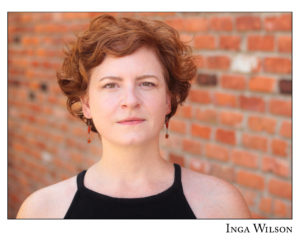
Hey, Inga Wilson! You’re an actor and a director. How does one inform the other? Can you relate this to the rehearsal and development of any of the short plays in Bunfight?
Inga: As an actor I like to have space to explore the character within the framework the director provides. So as I director I like to give actors that same space. I believe so much magic happens in the tiny accidents that come up in rehearsal. One example happened in your piece Cornucopia… one actor was trying to get the other actor to hand him a specific piece of the broken table and doubled the line unintentionally. We ended up keeping it because it helped facility the other actor in getting upset and motivating their movement. I believe the happy accidents help create the feeling of “now” that is so exciting in theatre and helps audiences feel like they’re watching something true unfold before their eyes for the first time.
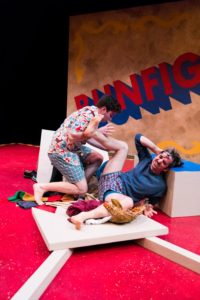
How do you balance creative life and all of the rest of it?
Hmmm… I don’t know. “Work life balance.” How do you do it? I rely heavily on my google calendar and I schedule all of it – work, creative projects, time with family and friends. Working a gig lifestyle, I don’t typically get whole days off, so I try to make the most of whatever down time I can get!
What’s it like making art in your community? How does a project like Bunfight tell us about where you live?
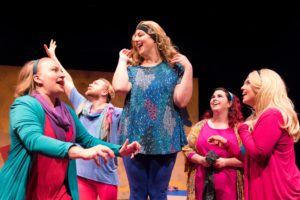
The theatre community in Eugene is very supportive and because our community is so small, we’re a pretty tight knit group. That closeness really helps in projects like Bunfight that lack tons of prep time, and allows for a kind of short hand in creating relationships on stage. Take your piece Join the Movement – all of the actors had worked together in some capacity before so we were able to focus on other elements besides creating a group of close friends. For most of us, theatre is a tiny piece of all the rest that we’re doing, so it’s clear that folks really want to be there.
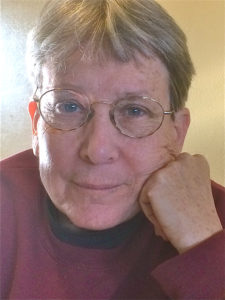
Hi Carol Dennis! Tell me about Minority Voices Theatre, the Very Little Theatre, and the people in our community that’ve helped to bring At Winter’s Edge to the stage.
Carol: Minority Voices Theatre (a community outreach project of the Very Little Theatre) was born in January, 2017. Co-founded with my friend, Stan Coleman, MVT has two main goals: to use community members as actors in staged readings of plays that represent marginalized and underrepresented populations; and by doing so, build an audience and a more diverse pool of actors in this very white part of the country, encouraging other theatres in the area to be more representative of the whole community.
The Very Little Theatre is one of the longest continuously running community theatres in the country – currently in its 91st season.
Last year, I proposed the idea of directing a play at VLT in the “holiday” slot that was not just about Christmas (which had been the standard fare in that slot for years), but would instead explore the myriad ways people get through the holiday season. The previous year, I had help to create a new play (Now, I Am Your Neighbor by Nancy Hopps) about the experiences of immigrants living in this area. Interviews were conducted with local immigrants, and a play was woven together using their stories. I proposed using a similar process for this new holiday play, and the idea was accepted. At that point, I contacted you with the basic story (late December – people stranded at an airport) and asked if you’d be interested in writing this new play. You said yes, and MVT commissioned the play.
I started contacting people from the Neighbor project, and other actors I had seen in productions at the VLT, asking each to be in this new play and to lend their life stories to the characters they would play. Soon we had a list of people to interview and the process began.
What’s it been like, to develop a brand-new play?
Developing At Winter’s Edge was more challenging than expected, maybe because in this project I wore different hats. First, I was the commissioning party (on behalf of MVT). In the six months of writing, we would would meet to review the draft and I would give feedback and make suggestions for changes. I had very specific ideas about the message I wanted the play to send, at the same time, I wanted to give you the creative freedom to write “your” play.
As the director, I worked closely with you for the first two weeks of rehearsals, and you made changes to the script based on what you saw, and on my and the actors’ feedback. As the director, it was exciting to help shape the story, but my work really started the moment you handed off the play and I could fully embrace my vision of the play and bring that to life.
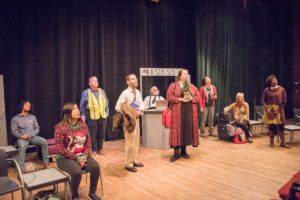
Your career as a director spans decades. Any advice for someone just starting out in this art form?
My bible is Harold Clurman’s book On Directing. In it, he talks about finding the spine of the play – the central theme that every storyline and every character revolves around. When the core of the play is solidly defined, it informs all of the moment-to-moment decisions you’ll be making as you guide actors through the play and create the arc of the story. Also, I don’t try to discover what the playwright was trying to say with the work. If we all did that, then every production of a play would be the same. Discover what the play is saying to you, and trust that that message or theme will be universal enough to speak to your audience.
WHO’S WHO?
Elizabeth Helman received her BA in Theatre and English (Creative Writing) at Santa Clara University and earned her MA and Ph.D. in Theatre Arts at University of Oregon in 2006. She is the Theatre Arts Area Coordinator at Oregon State University and teaches courses in history, literature, performance, directing, and playwriting. She has worked as a director, actor, playwright, costume designer and educator in the theatre for nigh upon these many years and makes the most of her Oregon life through long-distance running, cooking, attempts at gardening, and keeping chickens. She shares her adventures with her beloved husband, Matt, and rescue terriers, Wheatley and Emma. She blogs about directing here: My Rad Life and she blogs about directing Shakespeare here: Project Shakespearia
Inga Wilson received a BFA in Theatre Performance from Drake University and went on to study at the O’Neill National Theater Institute and Chautauqua Theater Conservatory. Inga has worked professionally as an actor and director in California, Illinois, Michigan, Minnesota, New York, and Oregon, as well as, teaching theatre for diverse audiences of all ages. Inga’s LinkedIn
Carol Dennis is the co-founder of Minority Voices Theatre, a director and producer of theatre that creates a sense of belonging. New York City Off-Broadway and National Tours in the 1970s; the Mark Taper Forum, Las Palmas, and Doolittle Theatres in Los Angeles in the 1980s; Eugene, Oregon community theatre for the past 30 years. Minority Voices Theatre
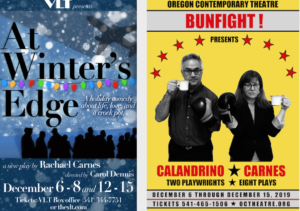
TICKETS!
BUNFIGHT, featuring four short plays by Rachael Carnes and four by Paul Calandrino, and AT WINTER’S EDGE, both continue Thurs-Sun, 12/12-12/15. Tickets at Oregon Contemporary Theatre and The Very Little Theatre.
